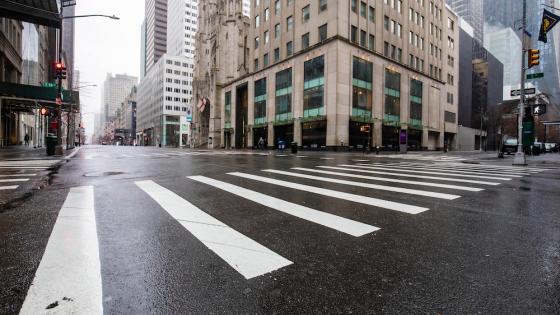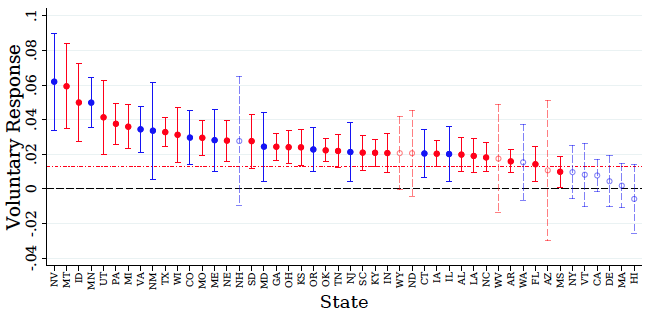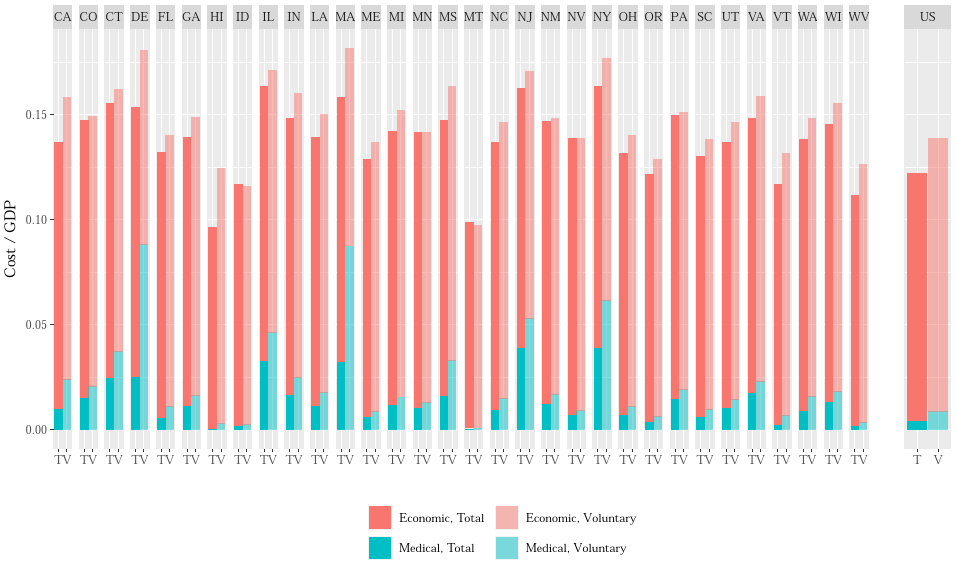With few exceptions, governments around the world have implemented lockdown policies in order to combat the COVID-19 pandemic. Public debates over the costs of such measures have typically assumed that the extent to which populations socially distance, and the associated economic costs, are mostly within the government's control. What is largely missing in these debates, however, is the recognition that the economic costs of the pandemic will be substantial even in the absence of lockdowns, since the spread of the virus causes a significant increase in voluntary social distancing (Chudik et al. 2020, Brzezinski et al. 2020a). This suggests that the counterfactual additional costs of a lockdown might be lower than commonly assumed.
Indeed, in a recent paper (Brzezinski et al. 2020b), we find that lockdown policies have been economically more efficient than staying open in the US. To obtain these results, we combine microeconometric methods with an epidemiological model that allows for societal and political response to the virus in order to estimate the costs and benefits of lockdown policies.
Our argument builds on two pillars:
- First, we find that the additional economic costs due to lockdowns are relatively low, once accounting for the voluntary response that would occur in the absence of such policies. This is in line with forecasts for 2020, which predict similar contractions in most developed countries (European Commission 2020) even if they did not impose lockdown measures, like Sweden. It also aligns with earlier research that showed credit card consumption only marginally less in Sweden, than in neighbouring Denmark, which did lock down (Andersen et al. 2020). Research on unemployment data from the US further suggests that only one fourth of the claims has been caused by lockdowns (Baek et al. 2020).
- Second, the medical benefits of a lockdown are high because of the high hospitalisation rate of COVID-19. Taken together, our findings indicate that lockdown measures generate efficiency gains in terms of medical expenditures that offset the comparatively small economic losses caused by lockdown policies.
Voluntary and lockdown responses
We leverage daily county-level mobile phone data on movement patterns to study the impact of local outbreaks and lockdown policies on mobility. These data are considered crucial in mitigating the spread of COVID-19 (Oliver et al. 2020) and have been used in a wide range of applications (Allcott et al. 2020, Andersen 2020).
Our events of interest are the first county-level case and state-level stay-at-home orders issued over the course of March and April 2020. These allow us to estimate the voluntary and lockdown responses to an outbreak, respectively.[1] Due to the gradual occurrence of these events across the US, we are able to construct viable counterfactual scenarios using difference-in-differences designs. Our outcome variable of interest is the percentage of devices that stay home all day.
Figure 1 shows the estimated uptake in social distancing following the first COVID-19 case by state. The horizontal line indicates the estimated coefficient for the US as a whole, while the points correspond to state-specific estimates. Overall, the share of people that stayed home all day increased by around 1.8 percentage points in the US. This constitutes an increase of 5.1% compared to February 2020. As reduced mobility maps into lower economic activity, this implies that economic costs are inevitable even in the absence of lockdown measures.
Figure 1 Voluntary response, by state
Notes: The figure plots the difference-in-differences estimate for the change in the percentage of devices that stay completely at home following the first case in a county. Blue (red) lines correspond to Democratic (Republican) states as per the 2016 presidential election; dashed lines indicate parameters that are insignificant at p<0.05; confidence level: 95%.
This substantial uptake in social distancing is comparable in magnitude to citizens' response to lockdown orders. Using a similar approach, our results show that the additional lockdown-induced impact on social distancing is 5.3%. Thus, governments that rely solely on voluntary social distancing need to take into account that the behavioural change will be significantly smaller without a lockdown policy in place, but will nonetheless still lead to sizeable decreases in activity.
Estimating economic and medical costs
How do these patterns in social distancing map into medical and economic costs? We answer this question by studying a controlled SIR model (Gros et al. 2020) (the acronym stands for Susceptible – Infected – Recovered). In addition to the standard epidemiological SIR model, this framework introduces the possibility for changes in behaviour, such as social distancing, which influence the rate at which the virus reproduces. This additional parameter can be interpreted as the joint social and political effort to promote social distancing and therefore to mitigate the spread of the virus. In the context of the COVID-19 pandemic, the model allows us to split the reaction strength into the components related to voluntary and mandated social distancing. Then, based on the previously estimated coefficients, we simulate the outbreak for both a lockdown and a no-lockdown scenario.
Based on these simulations, we separately estimate the economic and medical costs arising from the pandemic. The medical costs are composed of the production loss due to infected workers going on sick leave and the medical expenses associated with infections. These costs are directly proportional to the number of infections over the course of the pandemic.[2] The economic costs depend negatively on the degree of social distancing, which can be measured by the relative decrease in the reproduction number. Overall, the model reflects the trade-off faced by governments between balancing medical and economic costs. Less-restrictive policies increase medical costs through the total number of infected individuals, while lowering the burden from reduced economic activity.
The medical and economic cost estimates are presented in Figure 2 for a selection of US states that imposed lockdowns. It shows the costs in terms of GDP per capita associated with the estimated total containment response (T) and the counterfactual voluntary response (V).[3] For the US as a whole, we estimate that COVID-19 generates costs of around 13.9% of annual GDP per capita under a laissez-faire scenario compared to 12.2% if a lockdown is imposed.[4] In other words, imposing a country-wide lockdown would reduce the loss incurred by as much as 1.7% over the course of the pandemic compared to a no-lockdown scenario.
The finding that lockdowns are efficient in lowering the overall costs holds consistently across all states considered.[5] Decreasing the measured containment response by lifting a lockdown would only marginally increase the economic costs, while at the same time drastically increasing the medical costs. This pattern is more pronounced in states where the overall containment response was insufficiently effective, such as New York, Delaware and Massachusetts. In these states, voluntary social distancing leads to relatively larger decreases in economic costs compared to states with more efficient containment responses such as Vermont and New Mexico. Yet, the small reductions in economic activity are more than outweighed by the much larger relative increases in medical costs.
Figure 2 Voluntary and lockdown costs, by state
Notes: The figure shows estimated costs under voluntary social distancing (V) compared to total social distancing (T) – which includes voluntary (V) and lockdown-induced reductions (L) in movement. Estimated costs for (T) are based on simulations of the discretized C-SIR model. Costs for (V) are re-estimated with α scaled by the estimated ratio V/(V+L) = V/T. Costs are in terms of GDP per capita. Costs for both (V) and (T) are broken down into economic (red) and medical (blue).
Conclusion
We provide evidence for the efficiency of lockdown policies in mitigating both the overall costs to the economy as well as the spread of COVID-19. The reason for this is that individuals engage in voluntary social distancing even in the absence of lockdowns, once the virus takes hold in their area. Hence, substantial economic costs are unavoidable, even when not locking down. Yet, the additional lockdown-induced social distancing plays an important role in preventing further medical costs. Indeed, for our estimates of the voluntary and mandated social distancing responses, all US states that imposed a lockdown would have incurred larger overall costs had they stayed open. Considering the correct counterfactual costs is therefore key in informing policy decisions during potential future waves of COVID-19.
References
Allcott, H, L Boxell, J Conway, M Gentzkow, M Thaler, and D YYang (2020), “Polarization and Public Health: Partisan Differences in Social Distancing During the Coronavirus Pandemic”, NBER Working Paper 26946.
Andersen, A L, E T Hansen, N Johannesen, and A Sheridan (2020), "Pandemic, shutdown and consumer spending: Lessons from Scandinavian policy responses to COVID-19." arXiv preprint arXiv:2005.04630.
Andersen, N (2020), “Early Evidence on Social Distancing in Response to COVID-19 in the United States”, SSRN
Baek, C, P McCrory, T Messer, and P Mui (2020), “Unemployment Effects of Stay-at-Home Orders: Evidence from High Frequency Claims Data”, IRLE Working Paper 101-20.
Brzezinski, A, G Deiana, V Kecht, and D Van Dijcke (2020a), “The COVID-19 Pandemic: Government vs. Community Action Across the United States”, Covid Economics: Vetted and Real-Time Papers, 7: 115–156.
Brzezinski, A, V Kecht, and D Van Dijcke (2020b), “The Cost of Staying Open – Voluntary Social Distancing and Lockdowns in the US”, Economics Series Working Papers, University of Oxford, Department of Economics: 910.
Chudik, A, M H Pesaran, and A Rebucci (2020), “Voluntary and Manda-tory Social Distancing: Evidence on Covid-19 exposure rates from Chinese provinces and selected countries.” CEPR Discussion Paper 14646.
European Commission (2020), “European Economic Forecast-Spring 2020 – Statistical Annex”.
Gros, C, R Valenti, L Schneider, K Valenti, and D Gros (2020), “Containment Efficiency and Control Strategies for the Corona Pandemic Costs”. arXiv:2004.00493v2.
Oliver, N, B Lepri, H Sterly et al. (2020), “Mobile Phone Data for Informing Public Health Actions across the COVID-19 Pandemic Life Cycle”, Science Advances, 6:33
Endnotes
1 As we explain in further detail in the paper, what we estimate is a lower bound on the voluntary responses, since we only capture the response due to local outbreaks while controlling for country-wide dynamics. This, however, biases the results against our hypothesis.
2 We abstract from capacity constraints and the loss of human lives, even though these factors would further strengthen our conclusions.
3 We only show the estimates for those states that clearly passed the peak of daily infections in our sample, since the model parameters are not identified otherwise.
4 These figures increase to 14.9% and 12.7% once taking into account the statistical value of a life.
5 The apparently smaller total costs under a no-lockdown scenario for ID, MT, NV are due to inaccuracies in the numerical approximation and discontinuities in the cost function.








